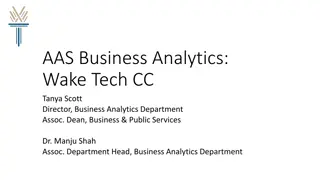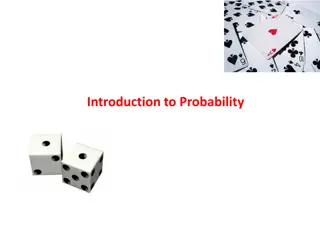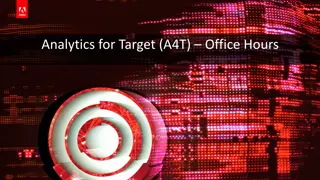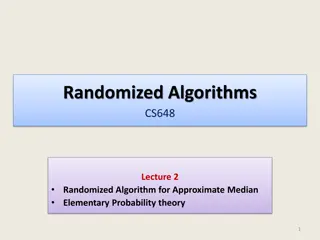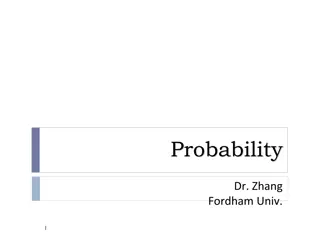Probability Basics and Problem Solving in Business Analytics I
Understanding the basic rules and principles of probability in business analytics, including conditional probability and Bayes Rule. Learn how to solve problems involving uncertainty by decomposition or simulation. Explore how beliefs can be updated using Bayes Rule with practical scenarios like identifying vehicles in a hit-and-run accident. Probability trees are used to illustrate the concepts.
Download Presentation

Please find below an Image/Link to download the presentation.
The content on the website is provided AS IS for your information and personal use only. It may not be sold, licensed, or shared on other websites without obtaining consent from the author. Download presentation by click this link. If you encounter any issues during the download, it is possible that the publisher has removed the file from their server.
E N D
Presentation Transcript
DECS 430-A Business Analytics I Probability Basics
The basic rules of probability: Pr(A) + Pr(not-A) = 1; Pr(A and B) + Pr(A and not-B) = Pr(A), and so on Pr(A or B) = 1 Pr(not-A and not-B) Pr(A or B) = Pr(A) + Pr(B) Pr(A and B) The basic rules of conditional probability: Definition: Pr(A|B) = Pr(A and B) / Pr(B) Pr(A and B) = Pr(A) Pr(B|A) = Pr(B) Pr(A|B) ; Pr(A and B and C) = Pr(A) Pr(B|A) Pr(C|A and B), and so on when A and B are independent, Pr(A and B) = Pr(A) Pr(B) when B1, , Bk are disjoint and exhaustive, Pr(A) = Pr(A|B1) Pr(B1) + + Pr(A|Bk) Pr(Bk), Bayes Rule, and how it works using probability trees
Solving Problems involving Uncertainty There is no mechanical approach that always works. Indeed, many important problems have no analytical (algebraic) solution at all! If there s no obvious answer, use the rules to decompose or transform the problem. Perhaps the new problem(s) will be easier to analyze. If this fails (either because we weren t sufficiently creative, or because there wasno simple answer) Use simulation to approximate the solution.
Bayes Rule (for Updating Beliefs, Given New Information) Beliefs can be updated using Bayes Rule: Pr( A|B ) = Pr( A B ) / Pr( B ) = Pr( A B ) / [Pr( A ) Pr( B|A ) + Pr( not A ) Pr( B|not A )] Equivalently, the calculations can be organized by using a probability tree. You may use whichever is more convenient.
Updating Beliefs, Given New Information A witness to a hit-and-run accident identifies the fleeing vehicle as a Ford. 20% of the vehicles in town are Fords. However, when shown a sample of photographs, the witness correctly identifies Fords only 90% of the time, and calls non-Fords Fords 30% of the time. How likely is it that the fleeing vehicle was actually a Ford? 20% 80% cars which are Fords cars which aren't Fords 90% 30% Pr( witness calls car a Ford | car is Ford ) Pr( witness calls car a Ford | car isn't Ford ) So, for example, 20% 90% 18% Pr( car is Ford, and witness says Ford ) Pr( car is Ford ) Pr( witness says Ford | car is Ford )
A Probability Tree 20% 80% cars which are Fords cars which aren't Fords 90% 30% Pr( witness calls car a Ford | car is Ford ) Pr( witness calls car a Ford | car isn't Ford ) 18 % P r( is Fo rd , an d w itne ss sa y s "Fo rd ") "F or d" 9 0% 1 0% Fo rd "not F or d" 2% P r( is Fo rd , an d w itne ss sa y s "not Fo rd ") 20% 80% 24 % P r( is not Fo rd , an d w itne s s s ay s "Fo rd ") "F or d" no t F or d 3 0% 7 0% "not F or d" P r( is not Fo rd , a nd w itne s s s ay s no t "F ord ") 56 %
Bayes Rule, using the Probability Tree 18 % P r( is Fo rd , an d w itne ss sa y s "Fo rd ") "F or d" 9 0% 1 0% Fo rd "not F or d" 2% P r( is Fo rd , an d w itne ss sa y s "not Fo rd ") 20% 80% 24 % P r( is not Fo rd , an d w itne s s s ay s "Fo rd ") "F or d" no t F or d 3 0% 7 0% "not F or d" P r( is not Fo rd , a nd w itne s s s ay s no t "F ord ") 56 % Pr(is Ford | witness says Ford ) = Pr(is Ford and witness says "Ford") Pr(witness says "Ford") 18% = 18% + 24% = 47.37%
THE WALL STREET JOURNAL AUGUST 14, 2006 Which Travelers Have 'Hostile Intent'? Biometric Device May Have the Answer By JONATHAN KARP and LAURA MECKLER At airport security checkpoints in Knoxville, Tenn. this summer, scores of departing passengers were chosen to step behind a curtain, sit in a metallic oval booth and don headphones. With one hand inserted into a sensor that monitors physical responses, the travelers used the other hand to answer questions on a touch screen about their plans. A machine measured biometric responses -- blood pressure, pulse and sweat levels -- that then were analyzed by software. The idea was to ferret out U.S. officials who were carrying out carefully constructed but make-believe terrorist missions. The Israeli-developed system combines questions and biometric measurements to determine if a passenger should undergo screening by security officials. In theory, the Cogito machine could be customized for specific cultures, and questions could be tailored to intelligence about a specific threat. The biggest challenge in commercializing Cogito is reducing false results that either implicate innocent travelers or let bad guys slip through. Mr. Shoval's company has conducted about 10 trials in Israel, including tests in which control groups were given terrorist missions and tried to beat the system.
Motivating example: Cogito What are costs/benefits of purchasing Cogito technology? 5-minute screening test for each traveler. Follow up inspection for those who fail screening. $200K per machine. Catch terrorists. How accurate is Cogito? How accurate do they want to be? If someone does not pass the screening, how likely is he/she to be a terrorist?
Cogito (primary product of Suspect Detection Systems Inc.) If someone does not pass the screening, how likely are they to be a terrorist? In the latest Israeli trial, the system caught 85% of the role-acting terrorists, meaning that 15% got through, and incorrectly identified 8% of innocent travelers as potential threats, according to corporate marketing materials. The company's stated goal is to prove it can catch at least 90% of potential saboteurs -- a 10% false-negative rate -- while inconveniencing just 4% of innocent travelers. Need assumptions. 750,000,000 passengers fly per year (U.S.). Assume 100 terrorists fly within a year.
The Probability Tree test positive 3.9999995% 4% is innocent 96% 95.9999872% test negative 99.9998667% 0.00001333% test positive 0.0000120% is a terrorist 90% 10% 0.0000013% test negative Pr( is a terrorist | test positive ) = 0. 0003% (about 1 chance in 333,000) number of innocents hassled / year 30,000,000 number of terrorists who still get through 10
Knowing This, Would You Have Invested in Suspect Detection Systems Inc.?
Independence of events Events A and B are independent if learning that B has happened does not change our assessed likelihood of A happening. Equivalent definitions: How Likely Is It That Birth Control Could Let You Down? P(A | B) = P(A) P(A | not B) = P(A) P(B | A) = P(B) P(B | not A) = P(B) P(A and B) = P(A B) = P(A) P(B)


